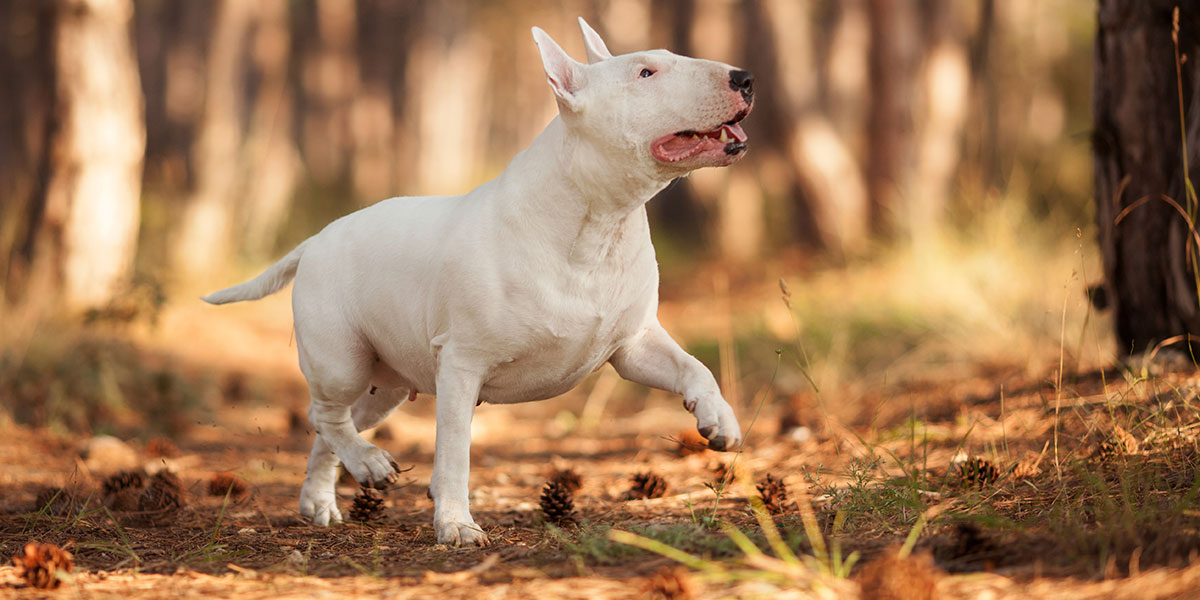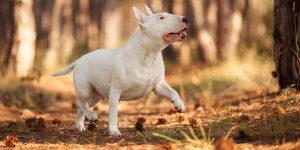
Bull Terrier – Terrier

Image: Alexandra Morrison Photo/Shutterstock.com
| Name | Bull Terrier |
|---|---|
| Size | Medium |
| Grooming | Not A Lot |
| Training | Moderate - Difficult |
| Exercise | 1 hour a day |
| Origins | England |
The Fighting Dog With A Heart of Gold
Quick Overview
The Bull Terrier remains a victim of its past, retaining a bit of a reputation for aggressiveness and sadly it remains on the dangerous dog list in many countries. However, this is more based on its history (there were bred to fight). Nowadays they are popular show dogs and make friendly affectionate companion dogs, who adapt well to apartment and town living, needing comparatively little exercise and of course they are dead easy to groom. So if this sounds like your kind of dog have a read and learn a little more about this maligned breed.

Image: Serova_Ekaterina/Shutterstock.com
Name: Bull Terrier
Size: Up to 22 inches tall.
Weight: 50-70 lbs
Grooming: Just teeth and claws.
Exercise: 1-1.5 hours of moderate walking a day
Training: Reasonably stubborn
Origins: England
Lifespan: 10-14 years
Breed Type: Terrier
History of the Bull Terrier Breed
The bull terrier was not originally bred to be a Ratter, as most English terriers aware at the time. Back in the Victorian era, dog fighting was a common blood sport among the lower classes. Those who worked through the Industrial Revolution, those who fuelled the erection of the train line and transport links, those who worked in factories, those who turned the mills, all of them had a long-running history of dogfighting. This was a recorded sport in Britain as early as the 13th century A.D. The fact that it happened does not make it acceptable and fortunately today it is outlawed in most civilised countries.
Dogfighting saw dogs mauled to death in cages or rings made in basements of the cities across the land. The Bull terrier was known to be particularly ferocious, with its long and rounded head as a preferred trait. The longer the snout, the more teeth, the more teeth, the more likely it was to win. Dogs would be pit against rats or (even more likely) against each other. Men would gather to bet on who would win and one dog would be carried away in a bag. This practice is truly barbaric.
Around 1830, just before the arrival of the railroad, the practice of dogfighting in Britain was forbidden by law. Of course, laws set in London have extraordinarily little impact on what happens in northern streets on Friday or Saturday evening, and in hidden places like basements. It took many years for dogfighting to be completely eradicated within the UK and even now, the occasional fight arises. A similar practice in the UK which is still used today is badger baiting, where dogs are set against badgers. None of this should be happening in the modern world.
By the middle of the 19th century, the Bull terrier had become quite popular among the middle-class gentlemen. Breeders turned their attention to refining that elongated snout and breeding for appearance instead of fighting spirit. It was this switch to breeding for appearance that stopped those ferocious features evolving, but also left the Bull terrier with a little bit of an attitude problem.
Modern times in the UK see the Bull terrier as fairly popular among those who want a dog that will scare off the neighbours. It’s not really ferocious anymore, but it still looks the part. Your Bull terrier will cuddle into you at night while simultaneously scaring away bad guys. We think that’s probably why they’re still so popular to this day.
Fun Facts About Your Bull Terrier Dog!
Every dog breed has fun facts to flaunt in front of the other’s noses. For the Bull Terrier, the game is amplified over fierce debate about the beauty of those long snoots. Love them or hate them, here are some Five Minutes Spare hard facts that may or may not entertain you:
- There is a Bull terrier club that is just waiting for you to join it…
- Bull terrier was a pit fighting dog, which was outlawed in Britain until the 1830s.
- You will find them in both the UK Kennel Club and in the UKC, among others.
- Bull Terriers arrived in America in 1885. It is the 13th most popular dog there to this day.
- The early history of the Bull terrier saw them crossed with Staffordshire terriers in order to gain a greater colour palette than the simple black and white that they had so far.
As you can see, bull terrier has more going for it than just a super-sized snoot!
Are They Hard to Train?
Unfortunately for the budding bull terrier owner, they tend to be fairly hard-headed. This is in a pun on their egg-shaped heads but is a reference to their notoriously difficult nature. The bull terriers friendly and family orientated but because they were bred for fighting the have developed a knack for making their own decisions. Your pet bull terrier will look at you, listen to your command, and then decide for itself whether or not to obey you.
Do they Need lots of Exercise?
Your Dog will need a bit of walking or running about but can get by on less than many comparable size dogs. Aim for at least an hour a day with 2 hours now and then. Some Bull Terriers require a lot less than that and one long walk and a good hearty play should do the trick. Given they were historically used as fighting dogs, short sharp bursts of energy are the norm with this breed (most dog fights didn't last long). They often get a case of “The Zoomies” which is when your dog runs in circles at top speed around the backyard or house.
How Often do I Groom my Bull Terrier?
You bull terrier is likely to need minimal grooming. This doesn’t mean that you can neglect their claws or their teeth, though. Dog’s toenails should be kept short by frequent walks on hard surfaces or by trimming at the vet or at home similarly, the teeth should be brushed at least once a week. You will find that this helps with bad breath.
Are they Healthy Dogs?
This particular dog breed can be traced back through the ages. While it is desirable to have such a well-known dog as your companion, this long history comes with a greater likelihood of health issues. If you have (or if you’re about to buy) a Bull Terrier puppy, you should ask the breeder about past heart health of the pup’s family. You should keep an eye on the kneecaps as patella luxation is a common occurrence with this breed. You also have their kidneys checked at an early age. This is another reason to buy from a registered breeder since they will be able to give you the past family history of your pup.
Where Can I Buy a Bull Terrier From?
You should be able to buy a bull terrier puppy from any registered breeder with your local kennel club. While this gives you the most information on your dog’s family history, it isn’t the first port of call we would recommend for buying a bull terrier pup. We would always advise that you call local shelters and ask if they have any bull terriers or if they can call you when a bull terrier comes in, and that way you’re changing one wee doggy’s whole world for the better.
Got Five Minutes?
If you happen to still have Five Minutes Spare, you can head on over to our webpages. There you will find numerous articles on hobbies and interests, all sorts of other pets, and can even get your daily news by following us on Facebook. We can’t promise to change your life, but we can promise its a wise use of your next Five Minues.